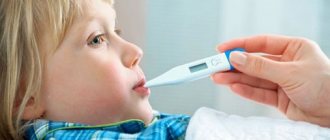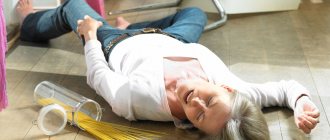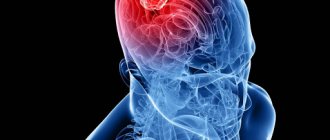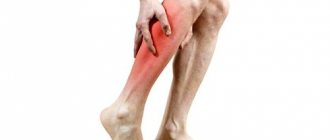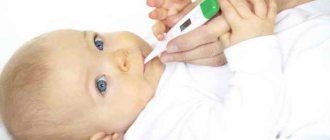Convulsions
– a sudden disorder of brain activity, manifested by various disorders in the motor, psycho-emotional, sensitive and vegetative spheres. Convulsions can occur with loss of consciousness, as well as against the background of preserved or partially preserved consciousness.
Seizures in children can occur at any age, but it is generally accepted that up to two-thirds of seizures occur in the first 3 years of life. Being a typical manifestation of epilepsy, seizures do not always indicate the presence of this disease in a child. Convulsive seizures are recorded in 5-10% of children, epilepsy is diagnosed in 0.5-1% of the population.
The causes of seizures in children can be:
- Perinatal disorders
- birth trauma, cerebral hypoxia/ischemia, intracranial hemorrhage, intrauterine infections (intrauterine infection of the fetus with rubella viruses, cytomegaly virus (CMV) or the causative agent of toxoplasmosis). - Infections
- meningitis, encephalitis, brain abscess. - Brain injuries
- brain contusion, less often concussion. - Metabolic disorders
- decreased levels of calcium, sodium, magnesium, blood sugar (respectively, hypocalcemia, hyponatremia, hypomagnesemia, hypoglycemia), increased sodium levels in the blood (hypernatremia), renal failure. - Increased body temperature
(febrile seizures) - Neurological diseases
- epilepsy, congenital malformations of the central nervous system, hereditary metabolic diseases (amino acid metabolism disorders, mitochondrial diseases, glycogenosis, etc.), phakomatoses (neurofibromatosis, tuberous sclerosis, etc.), brain tumors. - Drug withdrawal syndrome
is seizures in newborns born to mothers who use drugs.
Symptoms of manifestation
Those experiencing epilepsy for the first time can be quite shocked. Indeed, in most cases, attacks look frightening and are accompanied by the following symptoms:
However, not all forms of epilepsy are accompanied by such symptoms. Often the signs of epilepsy in infants are almost invisible, so sometimes parents do not pay due attention to them. But as soon as the baby’s behavior changes, you need to contact a specialist.
There is also a so-called aura or precursors to epilepsy. They appear about a day before the attack. The baby becomes capricious, constantly cries, and refuses to eat.
Minor seizures
In this case, epileptic foci spread only to part of the brain. Petite seizures include the following types of epilepsy:
Minor seizures can occur even during sleep. If epilepsy is accompanied by seizures, you need to ensure that the baby sleeps only in the crib. There should be no hard objects near it that it could hit.
Generalized
Symptoms of epilepsy in infants can be very pronounced. This happens with a generalized or grand mal seizure. The whole body is attacked by convulsions, the baby bends, his legs and arms can perform sudden chaotic movements. The face turns pale, foam comes out of the mouth, and involuntary bowel movements are possible.
The danger of such an attack is that the baby may hit himself due to severe convulsions. Teething babies may bite their tongues hard. This can lead to large blood losses. To avoid this, during an attack the baby should be placed on a soft pillow, and a special device for biting should be placed in his mouth.
The main clinical types of seizures in children:
- tonic
(synchronous/asynchronous tension of the muscles of the trunk, limbs) - clonic
(synchronous/asynchronous rhythmic contractions of all muscles) - tonic-clonic
(a combination of tonic and clonic seizures with a predominance of one or another component) - myoclonic
(repeated, often symmetrical contractions of individual muscles or muscle groups) - atonic
(sudden decrease in muscle tone) - infantile spasms
(short-term, successive symmetrical flexion/extensor contractions of the muscles of the neck, limbs and trunk) - absence seizures
(sudden short-term cessation of motor and speech activity with “freezing” of the gaze).
Epileptic seizure
Epilepsy is a chronic disease accompanied by disorders of consciousness and seizures.
a few hours or days before the onset of seizures, you may notice motor restlessness, labile mood, increased irritability, and sleep disturbances in the child.
The attack classically begins in a child with a cry (initial cry), followed by loss of consciousness (often to coma) and convulsions. The first phase of convulsions in children lasts 10-20 s and is characterized by tension in the facial muscles and extensors of the limbs; muscles of the body, the jaws are tightly clenched, the eyeballs deviate upward and to the side. The complexion is pale at first and later becomes reddish-cyanotic. The pupils are wide. There is no breathing. The second phase lasts from 30 seconds to several minutes and is manifested by short contractions of various muscle groups of the body. In both phases of the convulsive syndrome, biting of the tongue and lips may occur.
Subsequently, the child’s convulsions gradually decrease, the muscles relax, breathing is restored, the patient is motionless, and urine and feces often pass. After 15-30 minutes, sleep sets in or the child regains consciousness, completely forgetting the seizure.
How to help a child with seizures
- Place the patient on a flat surface (the floor) and place a pillow or cushion under the head; turn your head to the side and provide access to fresh air.
- Restore airway patency: clear the oral cavity of mucus, insert a small and fairly soft object between the teeth to prevent biting the tongue, lips and damage to the teeth. It is best to tie the edge of a towel or scarf (any other fabric) into a knot and place this knot between the teeth. Using hard objects (such as a spoon) for this purpose can result in broken teeth.
- Hospitalization after emergency care in a hospital with a neurological department. In the future, selection or correction of epilepsy therapy is necessary.
Diagnostics
Scope of required examination
a child with seizures is determined by the doctor individually, it depends on the nature, conditions of occurrence, and frequency of seizures; the general condition of the patient, the characteristics of his somatic and neurological status and may include an EEG, if necessary, EEG video monitoring, CT or MRI of the brain, lumbar puncture, biochemical studies of blood, cerebrospinal fluid, urine, etc. The purpose of the studies is to identify the possible cause of seizures and Establishing a diagnosis, allowing us to formulate the correct approaches to treating the child.
Convulsive episodes in newborns and young children are in most cases isolated and do not require further treatment. Recurrent seizures, most often associated with various types of epilepsy, require carefully selected and long-term therapy with anticonvulsants under the supervision of a pediatric neurologist (epileptologist).
The article presents the results of a study of 85 patients with neonatal seizures (NS). The issues of pathogenesis and treatment of these conditions are discussed, the importance of modern instrumental examination methods and the most common long-term consequences of NS are shown.
Modern approach to the understanding and treatment of neonatal seizures
Article conducted the results of the survey 85 patients with neonatal seizures (NS). Discussed questions the pathogenesis and treatment of these conditions, the importance of modern instrumental methods of examination and the most frequent long-term consequences of NA.
Despite the fact that neonatal seizures (NS) are the result of many causes, the main ones, according to most researchers, are ischemic-hypoxic encephalopathy, intracranial hemorrhage, infections and congenital malformations. All of the listed diagnoses are very general and do not meet the requirements of the modern classification of perinatal lesions of the nervous system [8]. Despite the fact that neonatal seizures are reliably considered a sign of severe neurological damage to the brain, they have generated much scientific debate about their pathogenesis. For example, is NS a consequence of brain damage or do what are called seizures damage the brain? Unfortunately, the risk factors for NS have not yet been sufficiently studied. Neonatal seizures are common and may be the first manifestation of neurological dysfunction after various injuries. Seizures in newborns are clinically significant primarily because very few of them are idiopathic. Further studies leading to timely diagnosis of the underlying condition are important because early initiation may improve prognosis.
Neonatal seizures lead to nonphysiological apoptosis, but it is not clear whether this leads to further clinically significant neuronal damage in all types of seizures, or whether negative consequences can be prevented with the help of therapy. Therefore, many clinicians are uncertain when treatment for seizures is required and how to assess the adequacy of treatment.
An immature brain seems more prone to seizures; they are more common during the newborn period than at any other time during life. This may indicate an earlier development of excitatory synapses that predominate over inhibitory influences at the early stages of maturation. The prevalence of clinical seizures in infants born at term is 0.7-2.7 per 1000 live births. The incidence is higher in premature infants, ranging from 57.5 to 132 per 1000 live births (birth weight <1500 g).
In 75% of patients, epilepsy debuts in childhood. Thus, in the future, in most cases, neurologists observe the evolution of epilepsy. Therefore, the most important thing is the time of onset of epilepsy, its adequate therapy with the main goal of avoiding the transformation of one epileptic seizure into another, achieving their maximum control.
Neonatal seizures are reliably recognized as one of the main neurological syndromes of children in the first 4 weeks of life. Today, this is one of the most controversial problems in neuroscience, starting with its definition. If we consider that NS is a generalized reaction of the newborn’s nervous system to various neurological, somatic, endocrine and metabolic disorders [9], then we can treat them as a transient symptom that does not require therapy, which is very widely represented in neonatology. Many other definitions of neonatal seizures are known. Unfortunately, none of them requires either a search for causes or research into the consequences of NS. We prefer the point of view of the majority of neurologists, who consider NS to be the first reliable sign of severe brain damage in a newborn, with the exception of idiopathic seizures, which are much less common [2, 3, 6]. A large scatter in statistics most often indicates its imperfection for many objective reasons. The minimum frequency of NS is most typical for underdeveloped countries, where NS often goes unnoticed by neonatologists or parents of newborns, and diagnostic methods are imperfect [4]. It is very important for clinicians and little known that latent seizures are more typical for newborns, they are also called electrographic seizures. Most electrical seizures are not accompanied by clinical correlates. At the same time, not all clinical seizures correlate with EEG changes. Neonatal seizures differ in clinical description from seizures in adults, and seizures in premature infants differ from seizures in children born at term. The organization of the cerebral cortex, synaptogenesis and myelination of efferent neurons are poorly developed in newborns, which rarely leads to bisynchronous propagation of excitation. Therefore, fragmented seizures are more typical in newborns, and electrical activity may not spread to the surface of the EEG electrodes. Only with the help of such a research method as video-EEG monitoring is it possible to differentially diagnose various types of apnea [2]. The phenomenon of electroclinical disconnection is most often determined in newborns with fragmented seizures, generalized tonic and focal myoclonic paroxysms, which may not be accompanied by simultaneous EEG correlates.
An analysis of the literature of recent decades shows that the majority of authors both in Russia and abroad are inclined to hypoxic-ischemic brain damage in the perinatal period as the main cause of NS [7, 8]. JM Rennie (1997) believes that seizures are a general response of the brain to a stroke [5]. D. Evans, M. Levene (1998) pay special attention to the significance of moderate and severe hypoxia-ischemia, when NS appears in the first 24 hours of a child’s life and has an unfavorable prognosis [2]. And H. Tekgul, K. Gauvreau and co-authors (2006), having conducted a study of 89 children with NS, indicate that in 82% of cases, global cerebral hypoxia-ischemia was detected in newborns of this group, which led to death in 7% of children and in 28% to severe neurological changes at the age of 12-18 months [6]. The term hypoxic-ischemic brain damage, generally accepted in the literature, is sometimes replaced by the outdated concept of “hypoxic-ischemic encephalopathy.” One way or another, the criteria for this most common and life-threatening condition in perinatology have not yet been determined. This is a set of indicators, which include the Apgar score not only at birth, but also after 5 minutes, the severity of acidosis, the need for mechanical ventilation, convulsions and others. The causes of NS are many pathological processes of the mother and child, including metabolic disorders, congenital cortical malformations, infections, of which bacterial meningitis is the most common.
The relevance of the study of neonatal seizures is determined not only by their insufficient knowledge, but also, to a greater extent, by their severe neurological consequences, which include motor disorders, cognitive deficits, social maladaptation and the formation of late epilepsy. Many scientific studies are devoted to the search for risk factors for the development of NS, which could help improve the algorithm for managing a patient with NS depending on the cause of its occurrence, neurological symptoms in the first hours of life, indicators of the energy balance of the newborn’s body and instrumental research methods [1, 3, 6, 7 ].
Taking into account the symptomatic nature of most neonatal seizures, we set ourselves the main task of determining the proportion of perinatal brain pathology and, in particular, intranatal pathology in the development of nervous system. We believe that it is no less important to evaluate modern approaches to the monitoring and treatment of patients with NS in practical healthcare. We consider one of the tasks to be the creation of an algorithm for the management of a newborn with NS.
Materials and methods . The study included 85 children aged 1 month to 17 years who had neonatal seizures. The exception was newborns with idiopathic NS. A thorough assessment of obstetric and early postnatal history was combined with a neurological examination of the child. Patients aged from 1 month. up to 1 year there were 33 (1st group), from 1 year to 5 years - 40 (2nd group) and from 5 years to 17 years - 12 (3rd group).
In the 1st age group, in the first days of life, 76% of patients, in addition to NS, had grade II-III cerebral ischemia verified, and in 24% of newborns it was combined with intraventricular hemorrhages and in 18% with CNS depression syndrome. It is customary to talk about the neurological consequences of perinatal brain pathology by the age of 12-18 months. By 1 year of life, 52% of patients with NS were diagnosed with epilepsy and 71% developed a persistent neurological deficit. In all infants, according to the results of ultrasound examination, blood flow disturbances were combined with signs of hypoxia. The undisputed generally accepted algorithm for examining newborns with NS in the world is neuroimaging (MRI and CT). None of the newborns from the first group of children we examined underwent neuroimaging in the first month of life. In 29% of the examined children with recurrent epileptic seizures, according to MRI and CT, gross changes were revealed - by the age of 1 year, the picture of internal ventricular hydrocephalus and cystic-atrophic changes in the cerebral hemispheres prevailed. NSG, as the most accessible diagnostic method, was performed in 60% of patients with NS. In 9 examined children, periventricular cysts predominated, in 4 - intraventricular hemorrhages, and in another 5 - signs of intraventricular hydrocephalus. Ophthalmoscopy data performed on 65% of patients showed partial atrophy of the optic nerves in 30%, and retinal angiopathy of varying severity in 70%.
When analyzing the anamnesis data of patients of the 2nd age group (1 year - 5 years), we did not note any large statistical differences in the symptoms of the first days of life. Subsequently, 60% of children developed cerebral palsy, in 22% of patients it was combined with symptomatic focal epilepsy and in 18% with symptomatic West syndrome. That is, by the age of 5, more than a third (40%) of children who suffered from NS suffered from epilepsy. According to MRI data performed on 13 children out of 40, mixed ventricular hydrocephalus was found in 13%, cystic atrophic changes were found in 10%, and anomaly of brain development was noted in 7%, in particular, hypoplasia of the corpus callosum. According to the results of ultrasound scanning, in 30% of patients asymmetry of blood flow in the vertebral arteries predominated, and in 20% of them it was combined with severe venous dystonia, in 7% of patients signs of hypoxia were described.
All 12 patients of group 3 (5-17 years old) had grade II-III cerebral ischemia during the neonatal period; The 100% rate of ischemic disorders in this group, in our opinion, has no objective reasons, but once again allows us to note the high frequency of hypoxia-ischemia in newborns with NS. The degree of ischemia predominated in very preterm infants, as did the frequency of neurological consequences. The data from the neurological examination and instrumental research methods did not differ from the two previous groups, which allowed us to conclude that neurological outcomes were developing by the age of 12-18 months in children with NS. We consider the significant difference between the 3rd age group and the first two to be the frequency of headaches (73%) and cognitive impairment in the form of decreased memory, perception, and concentration in 62% of patients tested by a psychologist. It is in this group of patients that one can reliably judge the long-term consequences of neonatal seizures. And the most common late complications turned out to be cephalgia, essentially perinatally caused, and attention deficit disorder.
The diagnosis of epilepsy today requires mandatory EEG monitoring, that is, continued EEG recording. Unfortunately, we found that even routine EEG is not performed on all patients with NS, either in the first days of life or during the first year. The reason for this study was the onset of seizures, which required differentiation from epileptic ones. Continuous EEG is recommended for children with perinatal pathology of the central nervous system and nervous system, in order not to miss seizures in the event of their visual absence, to determine the frequency and duration of seizures. Unfortunately, access to EEG monitoring is limited in most clinics, and interpretation largely depends on the EEG performer, requiring considerable experience. Detection of interictal abnormalities in background EEG is useful in determining prognosis in both term and preterm neonates. The worst prognosis is associated with a burst-suppression pattern and persistence of persistent low-amplitude waves.
33 patients with NS aged from 3 months. up to 17 years of age, video-EEG monitoring was performed in a hospital setting. When monitoring wakefulness in a background recording, organic changes were recorded on the EEG in 60.6% of cases (20 people). The vast majority - 72.7% of patients (24 people) showed epileptiform activity during the study. In 15.2% (5 people) hospitalized in the department of infants and young children with damage to the central nervous system and mental disorders with a diagnosis of symptomatic West syndrome, electroencephalographic changes characteristic of various variants of modified hypsarrhythmia were noted.
In symptomatic focal and multifocal epilepsy, regional and multiregional epileptiform changes were recorded in 51.5% (17 people) of cases, in 3% of cases (1 person) complexes reminiscent of benign epileptiform patterns of childhood were noted. In one child, suppression of cortical rhythms was recorded on the EEG.
In 21 patients, video-EEG monitoring was performed after receiving the results of routine EEG. During the initial routine EEG, epileptiform disorders were detected in 23.8% of children with a history of neonatal seizures. Video-EEG monitoring of wakefulness and sleep revealed epileptiform activity in 85.7% of cases, and in 61.9% of cases epileptiform activity was detected for the first time only during an EEG monitoring examination, that is, a routine EEG method using a standard technique for recording bioelectrical activity of the brain did not reveal epileptiform disorders. Isolated, only in a state of sleep, epileptiform activity was detected in 28.6% of cases, which increases the significance of conducting EEG monitoring studies in this physiological state.
The main goal in the treatment of neonatal seizures is to relieve the symptoms of the underlying disease and maintain optimal respiratory parameters, blood glucose-electrolyte composition and thermal conditions. The biggest debate is the question: to treat or not to treat NS? Prolonged or poorly controlled neonatal seizures are associated with a worse outcome than infrequent or easily controlled seizures, but the severity of the underlying disorder may lead to poor seizure control and poor outcome. There are no clinical data to show that anticonvulsant treatment changes neurological outcome when controlling underlying neurological impairment. Many of the most commonly used AED regimens are ineffective in controlling all seizures, clinical or electrical. Abnormal EEG activity persists in a significant proportion of neonates who show a clinically positive response to AEDs.
It may be necessary to attempt to control frequent or prolonged attacks, especially if homeostasis, ventilation, and blood pressure are compromised. It is considered necessary to prescribe AEDs if there are three attacks per hour or more, or if one attack lasts 3 minutes or more. After clinical seizure control, persistent EEG seizures are rarely treated because they tend to be brief and fragmented—further increasing dosages increase the risk of side effects. Many anticonvulsants depress respiration and impair myocardial function. The duration of therapy also causes considerable debate, but when seizures are controlled for a week and the neurological status is normal, AEDs are usually discontinued.
The drug of first choice in neonatal practice is still phenobarbital (PB) at a dose of 20-40 mg/kg/day in 2 doses. At the same time, recent studies show that FB suppresses only the clinical component of seizures and does not affect the frequency and duration of “electrical attacks”, that is, the phenomenon of electroclinical disconnection is formed. The second-line drug of choice is diphenin at a dose of 10-20 mg/kg/day. Studies in recent years show a good effect of valproate at a dose of 20 mg/kg/day. Data have emerged on the positive effects of topiramate in neonatal practice. To date, no reliable comparative data have been obtained on the benefits of a specific AED in the treatment of NS.
conclusions
1. Neonatal seizures in most cases are a consequence of perinatal damage to the newborn’s brain, and most often hypoxia-ischemia.
2. Most of the nervous system is not visualized and manifests itself only as hidden, “electrical” attacks.
3. To date, there is no algorithm for the management of patients with NS. EEG monitoring and neuroimaging are performed extremely rarely in the first days and months of a child’s life.
4. Treatment of NS is debated, but requires first of all eliminating the cause of the development of NS, starting from the first minutes of life.
5. The consequences of NS are persistent neurological deficits, cognitive impairment, and epilepsy.
E.A. Morozova
Kazan State Medical Academy
Morozova Elena Aleksandrovna - Candidate of Medical Sciences, Associate Professor of the Department of Child Neurology
Literature:
1. Arpino C. Prenatal and perinatal predictors of neonatal seizures in the first week of life C. Arpino, S. Domizio // Journal of Child Neurology. - 2001. - No. 9. - R. 17-23.
2. Evans D. Neonatal seizures / D. Evans, M. Levene // Arch Dis Child Fetal Neonatal Ed. - 1998. - No. 78. - R. 70-75.
3. Murrey DM Prediction of seizures in asphyxiated neonates: correlation with continuous video-electroencephalographic monitoring / DM Murray, CA Ryan, CB Boylan // Pediatrics. - 2006. - No. 1. - R. 1140-1151.
4. Mwaniki M. Neonatal seizures in a rural Kenyan District Hospital: aetiology, Incidence and outcome of hospitalization / Mwaniki, A. Mathenge, S. Gwer1 // Medicine. - 2010. - No. 8. - R. 8-16.
5. Rennie JM Neonatal seizures / JM Rennie // Eur. J Pediatr. - 1997. - No. 156. - R. 83-87.
6. Tekgul H. The Current Etiologic Profile and Neurodevelopmental Outcome of Seizures in Term Newborn Infants / H. Tekgul, K. Gauvreau, J. Soul // Pediatrics.-2006. - No. 6. - R. 1270-1280.
7. Zelnik N. Predictors of epilepsy in neonates with cerebral injury / N. Zelnik, M. Konopnicki, T. Castel-Deutsch // Paediatr Neurol. - 2010. - No. 14. - R. 67-72.
8. Guzeva V.I. Epilepsy and non-epileptic paroxysmal conditions in children / V.I. Guzev. - M., 2007. - 568 p.
9. Epileptology in medicine of the XXI century / A.A. Kholin, E.S. Ilyina, K.V. Voronkova, A.S. Petrukhin / ed. E.I. Guseva, A.B. Hecht. - M., 2009. - 572 p.
Symptoms of seizure syndrome
Convulsive syndrome in children develops suddenly. Motor excitement occurs. The gaze becomes wandering, the head is thrown back, the jaws close. Characteristic is flexion of the upper limbs at the wrist and elbow joints, accompanied by straightening of the lower limbs. Bradycardia develops. Possible respiratory arrest. The color of the skin changes, up to cyanosis. Then, after a deep breath, breathing becomes noisy, and cyanosis gives way to pallor. Seizures can be clonic, tonic, or clonic-tonic in nature, depending on the involvement of brain structures. The younger the child is, the more often generalized seizures occur.
Prevention of night cramps
To prevent the occurrence of night cramps, you must:
- Avoid dehydration. Pay attention to a sufficient amount of water consumed by the child, especially in hot weather;
Newborn drinking water
- For active children, ensure peace before bed: exclude lively games, listening to loud music;
- Monitor the temperature and timely ventilation in the baby’s room. A comfortable sleep temperature should be 18-20 degrees;
- Try not to turn on the lights in the baby's room at night. Soft lighting of low intensity while falling asleep is acceptable.
Seizures are an uncommon occurrence in young children. They always frighten parents, but are not necessarily symptoms of dangerous pathologies.
Features of the manifestation of night attacks
Night attacks occur with less severe symptoms, since brain activity is less intense during sleep. In addition, such seizures can only be observed during certain periods, due to which they are divided into several subtypes:
Another feature is that tonic convulsions are replaced by tonic-clonic ones, after which the baby falls asleep. In the tonic phase, erratic body movements appear. Due to the spasm, the chest becomes motionless, the baby breathes very slowly and silently. This phase lasts 20-30 seconds.
Then the clonic period begins, during which saliva involuntarily flows from the baby’s mouth, limbs tremble, and urination is possible. This period lasts 1-5 minutes.
As a result, the baby's sleep is disturbed, he becomes restless and cries. In older children, nocturnal epilepsy leads to nightmares.
First aid
If a minor seizure occurs, no special measures need to be taken. You just need to stay close to the baby until the attack is over.
And in case of major attacks, it is recommended to provide first aid. Usually the attack occurs suddenly. An adult with the child should do the following:
Until the baby comes to his senses, you need to monitor him. You can't leave him alone. It is also prohibited to give any medications until the attack is over.
Then the baby must be placed in the crib. Usually after an attack, breathing evens out and deep sleep occurs. There is a possibility that a second attack will occur. Therefore, you should not leave your child unattended for 2-3 hours.
If a seizure occurs for the first time, you must definitely call an ambulance. In addition, a medical examination is necessary if the seizure lasts more than 5 minutes or the baby received some kind of injury during it.
What can trigger seizures during sleep?
Diarrhea on a child's teeth during teething, how long does diarrhea last?
Not all newborns have convulsions during sleep that indicate the manifestation of pathologies in the activity of the brain and central nervous system. They can be triggered by the following factors:
- Flickering light in the room. It is a strong irritant for the infant’s not yet formed nervous system. The child's sleep convulsions caused by this factor immediately disappear after the light stops flickering or turns off;
- Lack of moisture. If the water-salt balance in the body is disturbed due to dehydration, then the electrical conductivity of nerve fibers is disrupted, which causes muscle spasms. Replenishing the body with moisture quickly solves the problem;
- Carrying out routine vaccinations. Very rarely, cramps when falling asleep in a child can be triggered by an allergic reaction to a vaccine;
- Increased temperature in the sleeping room. When the baby's body overheats, conditions are created in the body to reduce its oxygen saturation (hypoxia), which is a factor why convulsive spasms occur in the baby;
- High body temperature with respiratory infections, pneumonia.



